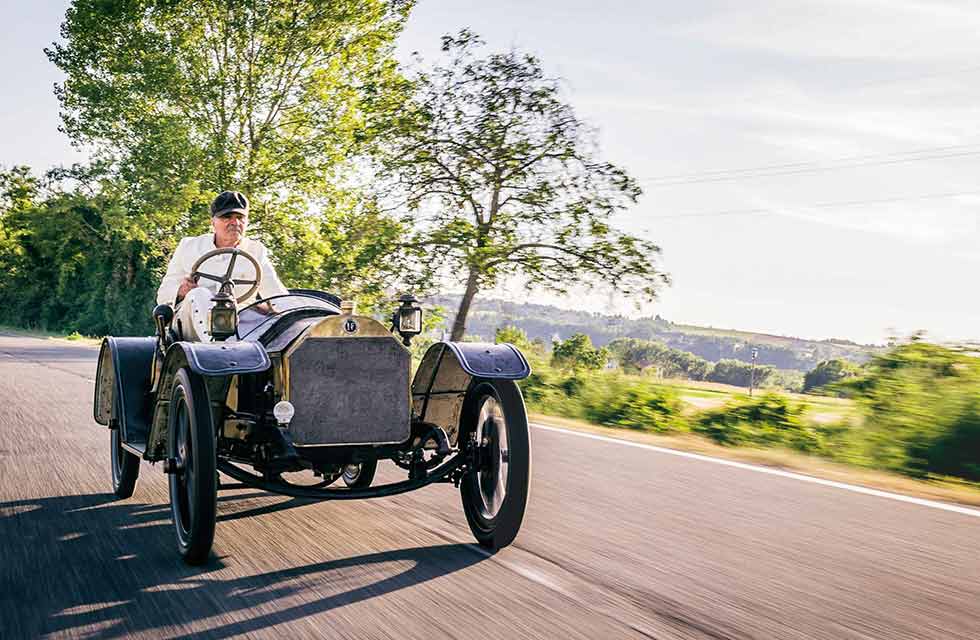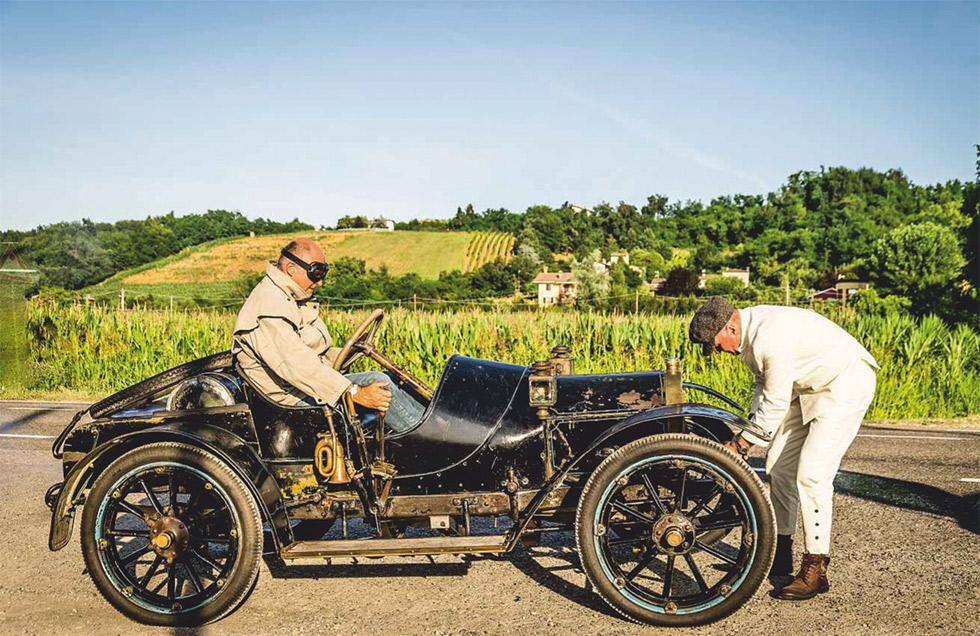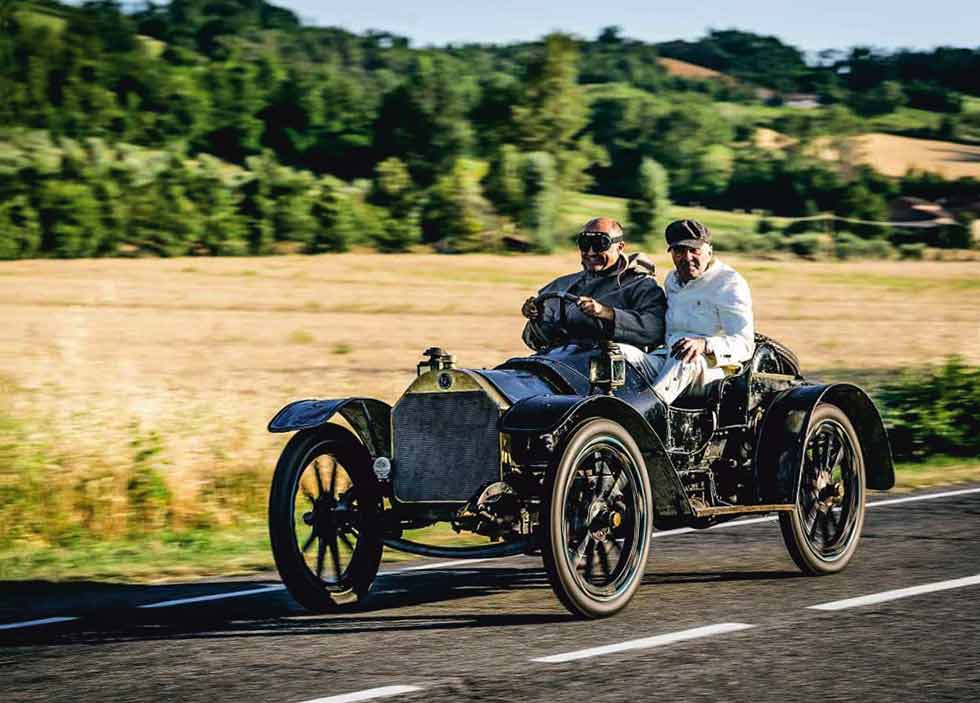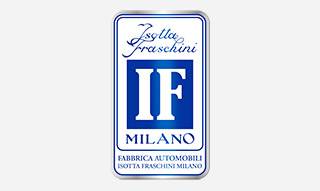
1909 Isotta Fraschini thicker than water. Massimo Delbò uncovers the incredible life story of a 1909 Isotta Fraschini Tipo FENC, owned by one family for 60 years – but hidden away for decades following a feud. Photography Max Serra.
ISOTTA FRASCHINI TIPO FENC
Hidden for decades, 110 years old, now driven
It was on 27 January 1900 that Cesare Isotta and Oreste Fraschini founded the Società Milanese d’Automobili Isotta Fraschini & C. Their aim was to establish a business selling and maintaining what was then the symbol of the future: the automobile. Within only a year they were designing and manufacturing cars under their own name, but it’s doubtful they even dreamed that their products would become renowned as the most advanced and luxurious of the period.

Only now, as we look back over Isotta Fraschini history, is it easy to see how the whole company – not just the cars and the engines it manufactured – was at the forefront of its craft, innovating before being followed by others, and developing ideas that remain valid more than 100 years later. One example is the concept of manufacturing a high-performance road car derived from a racing model: these days it’s simply good marketing, but in 1908 it was revolutionary. That’s when Isotta Fraschini launched the FENC, a road-legal version of the FE racing car.
‘This car, with its low centre of gravity and a wonderful feel as it flows along the road, is a delight to drive’
It was only a few years earlier, in 1903, that Isotta Fraschini had offered its first car fitted with an engine of its own design, engineered by Giuseppe Stefanini, who is today considered one of Italy’s great pioneers of motor engineering. In 1905 Stefanini was teamed with Giustino Cattaneo, who would soon be appointed Isotta Fraschini’s technical director and is also revered today for his expertise.
LOST ISOTTA FRASCHINI
1909 road-racer: 60 years in one family, hidden for 50

Cattaneo went on to design the family of ASSO aeroplane engines, used on the SIAI Marchetti S.55 X sea-planes that, in 1933, flew from Orbetello in Tuscany to Chicago and New York. He is also the man increasingly credited as the true father of the overhead-cam engine, rather than a certain Ettore Bugatti.
The first project born of their collaboration was the racing Model D in 1905, a 17.2-litre four-cylinder of 100hp, with overhead valves operated directly by an overhead camshaft. It was followed in 1908 by the Tipo FE, a lightweight racing car of 600kg, created to compete in the Voiturette class, with a 1.2-litre monobloc four-cylinder overhead-cam engine. It was capable of 100km/h and raced in France’s famous 1908 Grand Prix des Voiturettes in Dieppe, finishing eighth. The FE was quite successful, and prompted Isotta Fraschini to develop a sports version from the racing car, for use on normal roads.
The Tipo FENC 10 was first shown in November 1908 at London’s Olympia Motor Show, fitted with a lightly detuned FE racing engine that, apart from its oversized combustion chambers, bears similarities to a modern small sporting engine. With its capacity increased to 1.3 litres, the FENC featured a cross-drive water pump and magneto and was paired with a four-speed transmission. Its power rating was 14hp at 2500rpm. In the conversion from racer to sports car, the fuel tank was moved from the rear to a new position under the front seat.
‘It is a part of the family, with us through some incredible adventures since 1959’ current custodIan Girolamo Saccardo
In 1909, the only complete year in which the FENC was available, four different bodies were offered, from a stripped-back fenderless roadster to a tourer, complete with leather and cloth roof, fenders and lights. About 100 chassis were built, not a huge number even then – sales suffered as interest faded in small cars.
As was the Isotta Fraschini custom, many of its cars were exported far away, with Tipo FENCs arriving on continents as distant as South America and Australia. Little is known of this car’s early history, but with engine number 6095, chassis 6095 is one of the last built, a 10- 12hp with chassis-mounted gearbox, equipped with fenders and an open body. It remains completely original and has been in the same family ownership for 60 years.

‘It is a part of the family, with us through some incredible adventures since 1959,’ says current custodian Girolamo Saccardo, here at his home in Vicenza, Italy. In 1958 Girolamo’s father, industrialist Gian Luigi Saccardo, was one of the country’s best-known veteran car collectors when it was less a hobby, more an eccentricity. ‘My father loved sports cars,’ says Girolamo, ‘and was famous for his collection of early-20th Century racers and Bugattis, notably a Type 13 Le Mans and a Brescia.’
Gian Luigi Saccardo dreamed of owning a FENC. It was probably the best technical expression of the theme of his collection, but only four were known to survive at the time (since then, just a couple more have come to light). Three of those were kept in museums and only one remained in private hands, owned by Australian collector Lyndon Duckett. ‘I will not sell my FENC, because to me it is as unique as the Mona Lisa,’ Duckett told Saccardo.
But he didn’t lose heart and spread the word. ‘Back then, the classic car community was smaller and there was a network made-up of friends, and friends of friends, connecting them worldwide,’ says Girolamo. ‘One of my father’s friends was the collector Nicolas Franco Jr, the Ferrari importer in Argentina and a nephew of the Spanish dictator. He was desperately trying to find a Hispano-Suiza Alfonso XIII, younger than the FENC, built from 1911 to 1914, but another racing car developed for road use, and equipped with an overhead-cam four-cylinder engine. Mr Franco wrote to my father, stating that if he could help him find an Alfonso XIII for his collection, he would give him the FENC. He even attached a picture of a FENC, taken in front of an Argentinian barn.’
Saccardo Sr duly tracked down a Hispano- Suiza in France and the deal was finalised. ‘I still remember the FENC arriving in Genoa in 1959, and my father’s disappointment when he saw the small wooden crate. He was used to the bigger Isotta-Fraschinis and thought he had been deceived, but, when he opened it, his expression changed,’ says Girolamo. ‘We then brought the car to the private workshop owned by my father, where his cars were restored with the aid of Elio, his old and trusted mechanic. The news spread and everybody who had something to do with old cars came to see it, and it became the star of the collection.
‘Since day one, the idea was not to restore the FENC but to keep it completely original, removing some modern parts installed in Argentina to keep it road-legal. My father nicknamed her Mona Lisa, and she was treated like a princess, parked in the family garage – the only classic allowed there – just waiting for when she would be used for a meeting.’
But at the end of the ’60s the Saccardo family business was losing money and, in an effort to save it, Mr Saccardo sold most of his collection, keeping the two Bugattis – and the FENC.
‘That wasn’t the worst part,’ recalls Girolamo. ‘The real problems struck in 1970, when my mother and father’s marriage broke up. There were some arguments and, one day, my mother took the FENC away and hid it in a barn, where it remained, tucked away for years. My father went crazy about it, and did everything he could to track the car down. He even published a warning around Europe to caution anybody against buying it, and offered a reward for clues about the car’s whereabouts.’
But there’s a twist to the story. ‘To protect both the car and my mother’s rights, it was me who took the FENC apart, splitting the pieces into five different boxes, each easy to handle and safe to hide,’ says Girolamo. ‘I picked the “long-term storage” very carefully, finding a place that had the right characteristics for preserving the car for an extended period, without ever imagining just how long that would be. It was anything but an easy time, and I was subjected to very strong family pressures from both sides.’
Gian Luigi Saccardo passed away in 2015, leaving the Tipo FENC to his son. ‘He knew I had it and knew that, after so many years taking care of it, I would never sell it. At least in this, he was right.’
In January 2016 Girolamo drove with his friend Pierangelo Camparmò and son daniele to the place where the Isotta was hidden. ‘We were very excited when we started opening the boxes, because we had no idea what we would find. Everything was there, in good condition, with only minor blemishes caused by the passage of time. We loaded the van with parts and boxes, and we moved everything to where the three of us would put the FENC back together. Only we three would touch the car, to be sure of preserving everything as it was.’
Girolamo’s plan was simply to reassemble the parts, not to restore the car, preserving as much of it as possible. And so the first task was a deep clean and a full check to see if anything had gone missing over the decades.
‘I found that 99.9% of the car was complete!’ exclaims Girolamo. ‘Almost every single part was stamped with the right numbers, proving their incredible originality. The car had been through a good mechanical overhaul in the 1960s, and was in more than good condition, exactly how I had hoped it would be, and most of the to-do list was related to safety – for both the car and the driver – rather than real needs. ‘The radiator core was too far gone, so we had to replace it, and we had to replace some wooden panels that had rotted. We asked master carpenter Mauro Gavasso to create new wooden panels in the lower part of the car, which he did only after finding the correct type of old poplar boards to use as the raw material, and we asked the maintenance shop of the Bonfanti museum in Vicenza to clean and take care of the oil and the gas tanks.
‘We also had to remanufacture from scratch the glasses for the oiler, already missing when the car arrived from Argentina, plus the radiator cap, and the collector between the water pump and the radiator.’
Some grease nipples and a few other lubricating elements were fixed after being damaged during the dismantling process back in 1970, and the biggest single part remanufactured was the metal frame of the passenger seat. ‘In the 1960s, the original one was loaned to Giulio Dubbini, a friend of my family and an enthusiast car collector. His aim was to use ours as a template, and remanufacture a set of two for one of his cars. Unfortunately, after he died, his sons gave away all the old parts left by their father, including my seat frame. I asked my old friend Sergio Bedin, the owner of a metal workshop, and his eldest employee copied my driving seat, all by hand, without using a single machine.
‘Using the small pieces of original trim left as clues, we refurbished the seats in an identical material and I took the decision to replace the original tyres: they were too old, and very worn. We left the paintwork exactly as it was, even down to its small rust patches. To protect it, we covered the body and the paint with a layer of natural beeswax. New rubbers and gaskets were fitted where needed, and all that remained was to add new fluids. And so we brought the FENC back to life, keeping it as it had been in the past, so I can drive it on rallies and in classic car events.’
Girolamo believes that his preservation work would be meaningless if he were to add modern lights, indicators and so on, so I have to be extra careful while driving it, even on closed roads. A manful twist of the crankhandle, and the four-cylinder engine starts enthusiastically. The multi-plate clutch action is granite-like but setting off is not so difficult thanks to the engine’s torque. As always with old cars, managing the gearbox is the most difficult aspect, but I quickly learn from Girolamo that the trick is not to rev between gears, and just let the engine slow a little before selecting the next ratio, using your ear to dictate when.
While mastering that, you have to remember the central accelerator pedal, and not to use the brake pedal because it stresses the transmission – use the external handbrake instead. After only a few minutes it becomes second-nature, and the engine’s voice starts to speak an understandable language. Then the real enjoyment begins. This car, with its low centre of gravity and a wonderful feel as it flows along the road, is a delight to drive, clearly reflecting its racing origins: the more you drive it, the more you want to drive it.
There is a good reason why, in 1914, Lionel Martin picked a Tipo FENC chassis as a test bed for the first Aston Martin engine, and why the racing legend Arturo Merzario, after seeing us speeding along with this one, decided to stop by for a closer look. That’s exactly what you do when you see the Mona Lisa.
Thanks To Girolamo Saccardo, Fabrizio Taiana and the Historic Club Schio (VI).
TECHNICAL DATA FILE SPECIFICATIONS 1909 Isotta Fraschini 10hp Tipo FENC
Engine 1327cc OHC four-cylinder, iron block, Isotta Fraschini carburetor
Max Power 12bhp @ 2500rpm
Max Torque 29lb ft @ 1250rpm
Transmission Chassis-mounted four-speed manual gearbox, rear-wheel drive
Suspension Beam axles, semi-elliptic leaf springs
Brakes Pedal-activated transmission brake, rear lever-operated drums
Weight 600kg (chassis)
Top speed 60mph (est)
0-60mph 90sec
Facing page and above Close-up pictures show the remarkable patination of this ancient car, almost every part of which is original; crank-starting the Tipo FENC before Massimo takes a drive. Left and above It’s 110 years old and totally original, yet it motors along beautifully; the kit of parts was in remarkably good condition when unearthed after five decades hidden away. Clockwise from right Isotta outside an Argentinian barn in the late ’50s; on arrival in Italy, with a young Girolamo Saccardo and his mother; mechanic Elio at the wheel.






